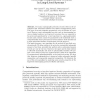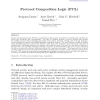13 search results - page 2 / 3 » Compositional System Security with Interface-Confined Advers... |
CRYPTO
2011
Springer
12 years 5 months ago
2011
Springer
Deterministic public-key encryption, introduced by Bellare, Boldyreva, and O’Neill (CRYPTO ’07), provides an alternative to randomized public-key encryption in various scenari...
CONCUR
2008
Springer
13 years 7 months ago
2008
Springer
Abstract. For many cryptographic protocols, security relies on the assumption that adversarial entities have limited computational power. This type of security degrades progressive...
JCS
2010
13 years 4 months ago
2010
Protocol authentication properties are generally trace-based, meaning that authentication holds for the protocol if authentication holds for individual traces (runs of the protoco...
ENTCS
2007
13 years 5 months ago
2007
Protocol Composition Logic (PCL) is a logic for proving security properties of network protocols that use public and symmetric key cryptography. The logic is designed around a pro...
CHI
2011
ACM
12 years 9 months ago
2011
ACM
Text-based passwords are the most common mechanism for authenticating humans to computer systems. To prevent users from picking passwords that are too easy for an adversary to gue...


